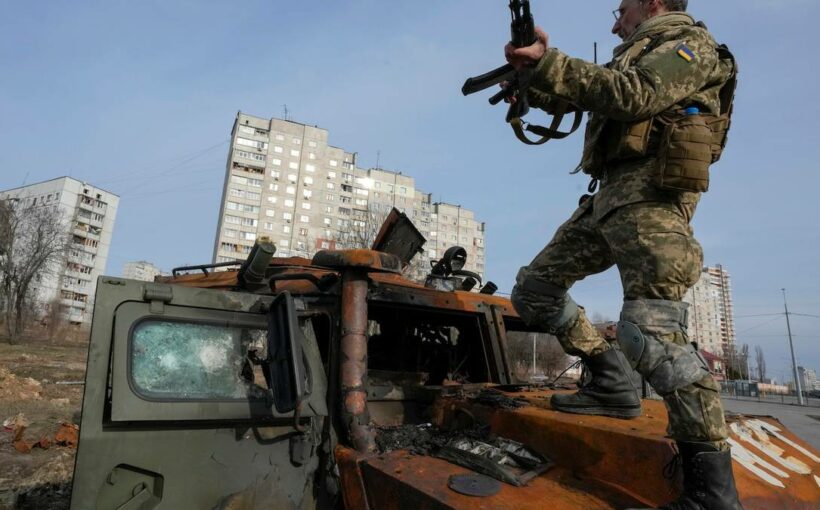The Russian assault on Ukraine is being hampered as most of its best missiles are failing to work properly, US officials have said.
The high failure rate of precision-guided munitions (PGM) may explain why Russia has not been able to destroy key military locations throughout the month-long war.
Up to 60 per cent of the missiles used to attack Ukraine either failed to launch properly or did not explode as expected on impact, according to the Pentagon.
US officials said Russia had fired about 1100 missiles of all kinds since the war started on February 24.
Defence experts have been baffled for weeks at Moscow’s inability to destroy Ukrainian airfields and other significant military bases.
Precision-guided munitions are aimed by laser or satellite signal to their targets. They can be steered to a certain degree by fins on the side of the weapon acting as miniature wings to “fly” the weapon to the ground.
As such they should be far more accurate than traditional unguided missiles that rely on gravity alone, sometimes called “dumb” bombs.
Images on social media have shown undetonated missiles lodged in playgrounds, cemeteries and other civilian areas. One rocket in Kharkiv, Ukraine’s second city, ended up lodged in a kitchen.
One video showed two Ukrainian soldiers removing the fuse from an unexploded bomb. With the sounds of explosions nearby and only red woollen gloves for personal protection, one soldier is seen slowly pouring water from a bottle over the fuse as a colleague gently unscrews it from the bomb.
The continued operation of Ukraine’s air force is seen as one reason Russian jets have preferred to operate at night, or fire their weapons from airspace in Russia or Belarus.
Missiles that struck the Ukrainian military base two weeks ago at Yavoriv, close to the border with Poland, were said by the US to have been air-launched cruise missiles fired from Russian airspace.
At least 35 people died in the attack, including three Britons believed to have been former members of 1st battalion of the Parachute Regiment.
Around 30 missiles were reported to have hit the site. A US official said a particularly high failure rate had been experienced during this operation.
Citing US intelligence sources, three Pentagon officials told Reuters the failure rate varied day-to-day. It also depended on the type of missile being launched.
One of the officials said the intelligence showed that Russia’s air-launched cruise missiles had a failure rate in the 20 to 60 per cent range.
Russia has been seen fielding two types of air-launched cruise missiles in Ukraine, the Kh-555 and Kh-101, the latter a very long-range cruise missile and sister to the nuclear tipped Kh-102, according to the Centre for Strategic and International Studies.
Douglas Barry, senior fellow for military aerospace at the International Institute for Strategic Studies, said if the Kh-101 wasn’t performing as it should do, “and that seems to be the case”, Moscow may also have an issue with its air-launched nuclear missile.
“The Russians don’t have as many PGMs in their inventory as the West [but] are in the process of recapitalising their inventory and replacing a load of old Soviet designs.”
The performance in Ukraine showed that process was not yet complete, he told The Telegraph.
Russia still using ‘dumb’ bombs
“We’re seeing Su-34s, which are capable tactical aircraft that the Russians have been bringing into service over the last 15 years, still armed with dumb bombs because they don’t have enough precision weapons to go round.
“There were a range of projects at the end of the Cold War [but] investment dried up for many years.
“They ran out of cash for a while and have run into technical problems.”
Missile failures can be caused by faulty weapons, or by the launch system – the jet or artillery gun – not operating correctly.
Ukrainian countermeasures, such as jamming guidance and navigation signals, may also account for some of the failures.
Munitions of this kind typically have a failure rate under 5 per cent in Western forces.
Poor maintenance throughout the entire military chain is thought likely to be another factor accounting for the high number of Russian losses.
“Is it the munition failing or the overall system with component failures elsewhere?” Barry asked. “A lot rests with the missile, but that’s not exclusive.”
Source: Read Full Article

/cloudfront-ap-southeast-2.images.arcpublishing.com/nzme/MI67N42SH6VXFWAJU6Z5OJCFCI.jpg)